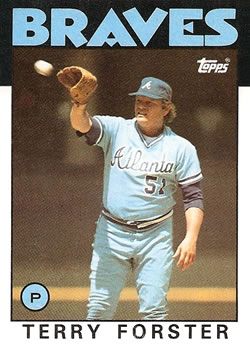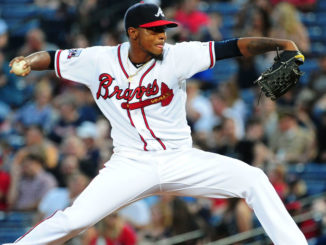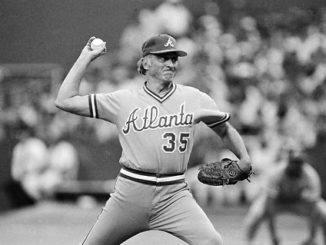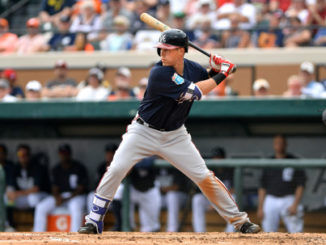
The best Brave to wear #51 is… Terry Forster.
Let’s just start with this:
A 2nd round pick in the 1970 draft by the Chicago White Sox, Forster dominated A-ball as a teenager and made his MLB debut in 1971 at the age of 19. He was, over the first few years of his career, one of the best relievers in the game. In 1972, he had a 2.25 ERA and a career high 29 saves in 100 innings of relief work. In 1973, he alternated between starter and closer and wound up with 16 saves and 4 complete games. In 1974, he led the AL with 24 saves while pitching 134.1 innings. When you look at modern baseball analytics and think those WAR totals are low for top relievers, it’s because today’s top relievers simply don’t provide the value that guys like Terry Forster did in the 70’s. Forster topped 2 WAR each year from 1972-1974, because he (and other relievers of the era) could not just be as good as today’s relievers, but he could do so for 2-3 innings at a time. 1975 was an abbreviated season due to injury, although still effective. He lost his role, however, as Chicago’s top reliever, to a young Goose Gossage that year. In 1976, Forster transitioned to more of a starting role, and it didn’t go as well – a 2-12 record with a 4.37 ERA, and like that, the White Sox had soured a bit on their once burgeoning star.
In December of 1976, the White Sox traded Forster and Gossage (!) to the Pirates for Silvio Martinez, a prospect who would go on to have one somewhat decent season with a team other than Chicago, and Richie Zisk – Zisk would at least have a career year for the Sox in 1977, slashing .290/.355/.514 with 30 bombs. Pittsburgh wisely returned Forster to the bullpen, but he wasn’t quite as effective as hoped (4.43 ERA). He became a free agent after 1977 and signed with the Dodgers.
With LA, he found his old form, saving 22 games with a 1.93 ERA in 1978, although he wasn’t eating innings as much as in his youth, preferring meatball subs instead. The Dodgers won the NL West in ’78, and Forster provided scoreless work in the postseason, including 4 shutout innings in a losing World Series effort. After the Series concluded, Forster had surgery to remove some bone chips from his elbow, and he would subsequently struggle with injuries for the next three seasons. He had a 4.30 ERA over just 58.2 innings from 1979-1981. In late ’81, though, he was healthy enough to make LA’s postseason roster, and Forster again shined in October, albeit in a limited role. In 4 postseason appearances, he pitched 2 2/3 innings and didn’t allow a run. The Dodgers defeated the Yankees, giving Forster the only ring of his career. In 1982, he was healthy and effective again, posting a 3.04 ERA and 3 saves in 83 innings of work, a nice bounceback going into his second round of free agency.
Forster signed with the Atlanta Braves. In Atlanta, Forster gained his old effectiveness as fast as he gained weight. The now-270 pound reliever was one of the NL’s best relievers in his three years in Atlanta, throwing 165.1 innings to a 2.29 ERA and 19 saves from 1983-1985. In 1985, he experienced newfound notoriety when David Letterman called him a “fat tub of goo” on national television. This led to not just the show appearance I posted above, but also… a novelty rap song. For real, y’all:
Forster really knew how to capitalize on the moment, and it even lasted years later:
The Braves released Forster at the end of 1986 Spring Training. He signed with the Angels and threw 41 innings of 3.51 ERA ball, picking up 5 saves, but that concluded his MLB career. He was only 34 during his final season, so you have to imagine he ran out of chances due to some combination of poor conditioning, recurring elbow problems, or a desire to achieve notoriety with novelty rap songs.
At the end of his career, Forster was 25th in MLB history in saves.
Oh, and one last thing. Here are the top 5 career batting averages in MLB history for batters with a minimum of 80 plate appearances:
- 2B/SS Ross Barnes (1871-1881): .359
- OF George Nicol (1890-1894): .362
- OF Red Dorman (1928): .362
- OF Ty Cobb (1905-1928): .366
-
Tub of Goo Terry Forster (1971-1986): .397
Forster got 31 hits in 78 at-bats over 86 plate appearances, with 4 doubles, one triple, and one stolen base.
Who Is the Best Ever To Wear #51?
Trevor Hoffman is on his way to the HOF, Bernie Williams probably should be in the HOF as one of the 5 or 6 best switch-hitters in history, and Ichiro is a beloved MVP with over 4000 professional hits.
But come on. You already know who it is.




Honorable mention to Mike Gonzalez.